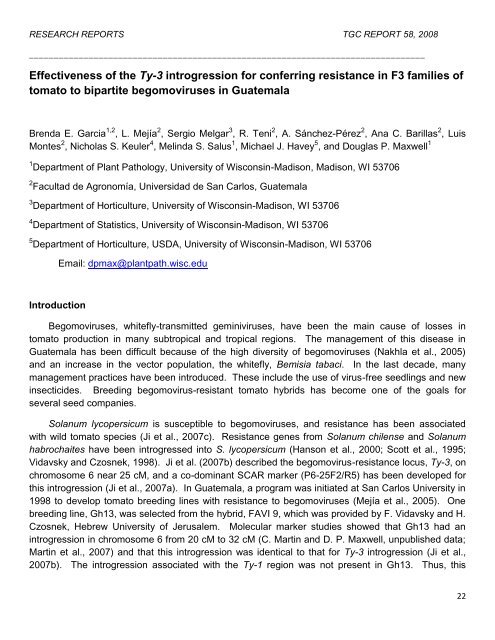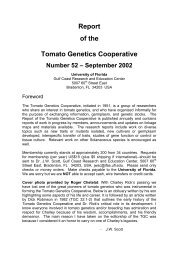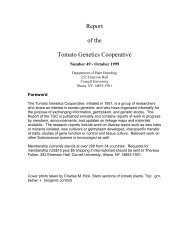Report of the Tomato Genetics Cooperative Number 58
Report of the Tomato Genetics Cooperative Number 58
Report of the Tomato Genetics Cooperative Number 58
You also want an ePaper? Increase the reach of your titles
YUMPU automatically turns print PDFs into web optimized ePapers that Google loves.
RESEARCH REPORTS TGC REPORT <strong>58</strong>, 2008<br />
________________________________________________________________________________<br />
Effectiveness <strong>of</strong> <strong>the</strong> Ty-3 introgression for conferring resistance in F3 families <strong>of</strong><br />
tomato to bipartite begomoviruses in Guatemala<br />
Brenda E. Garcia 1,2 , L. Mejía 2 , Sergio Melgar 3 , R. Teni 2 , A. Sánchez-Pérez 2 , Ana C. Barillas 2 , Luis<br />
Montes 2 , Nicholas S. Keuler 4 , Melinda S. Salus 1 , Michael J. Havey 5 , and Douglas P. Maxwell 1<br />
1 Department <strong>of</strong> Plant Pathology, University <strong>of</strong> Wisconsin-Madison, Madison, WI 53706<br />
2 Facultad de Agronomía, Universidad de San Carlos, Guatemala<br />
3 Department <strong>of</strong> Horticulture, University <strong>of</strong> Wisconsin-Madison, WI 53706<br />
4 Department <strong>of</strong> Statistics, University <strong>of</strong> Wisconsin-Madison, WI 53706<br />
5 Department <strong>of</strong> Horticulture, USDA, University <strong>of</strong> Wisconsin-Madison, WI 53706<br />
Introduction<br />
Email: dpmax@plantpath.wisc.edu<br />
Begomoviruses, whitefly-transmitted geminiviruses, have been <strong>the</strong> main cause <strong>of</strong> losses in<br />
tomato production in many subtropical and tropical regions. The management <strong>of</strong> this disease in<br />
Guatemala has been difficult because <strong>of</strong> <strong>the</strong> high diversity <strong>of</strong> begomoviruses (Nakhla et al., 2005)<br />
and an increase in <strong>the</strong> vector population, <strong>the</strong> whitefly, Bemisia tabaci. In <strong>the</strong> last decade, many<br />
management practices have been introduced. These include <strong>the</strong> use <strong>of</strong> virus-free seedlings and new<br />
insecticides. Breeding begomovirus-resistant tomato hybrids has become one <strong>of</strong> <strong>the</strong> goals for<br />
several seed companies.<br />
Solanum lycopersicum is susceptible to begomoviruses, and resistance has been associated<br />
with wild tomato species (Ji et al., 2007c). Resistance genes from Solanum chilense and Solanum<br />
habrochaites have been introgressed into S. lycopersicum (Hanson et al., 2000; Scott et al., 1995;<br />
Vidavsky and Czosnek, 1998). Ji et al. (2007b) described <strong>the</strong> begomovirus-resistance locus, Ty-3, on<br />
chromosome 6 near 25 cM, and a co-dominant SCAR marker (P6-25F2/R5) has been developed for<br />
this introgression (Ji et al., 2007a). In Guatemala, a program was initiated at San Carlos University in<br />
1998 to develop tomato breeding lines with resistance to begomoviruses (Mejía et al., 2005). One<br />
breeding line, Gh13, was selected from <strong>the</strong> hybrid, FAVI 9, which was provided by F. Vidavsky and H.<br />
Czosnek, Hebrew University <strong>of</strong> Jerusalem. Molecular marker studies showed that Gh13 had an<br />
introgression in chromosome 6 from 20 cM to 32 cM (C. Martin and D. P. Maxwell, unpublished data;<br />
Martin et al., 2007) and that this introgression was identical to that for Ty-3 introgression (Ji et al.,<br />
2007b). The introgression associated with <strong>the</strong> Ty-1 region was not present in Gh13. Thus, this<br />
22





